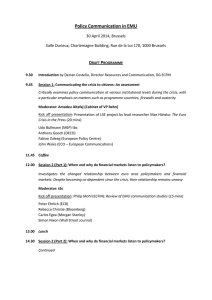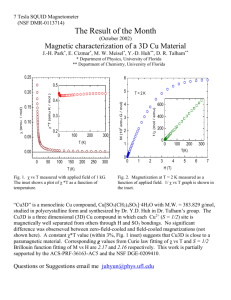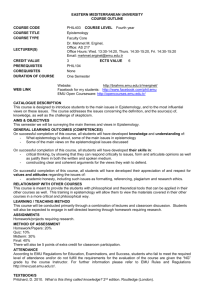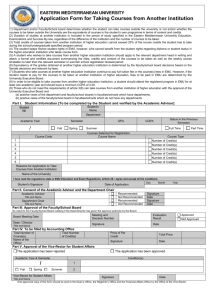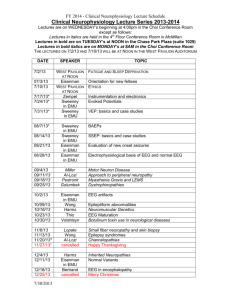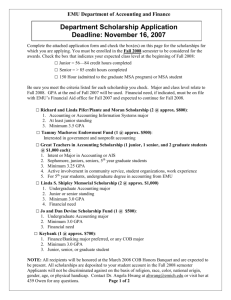1 - Encuentro de Economía Aplicada
advertisement
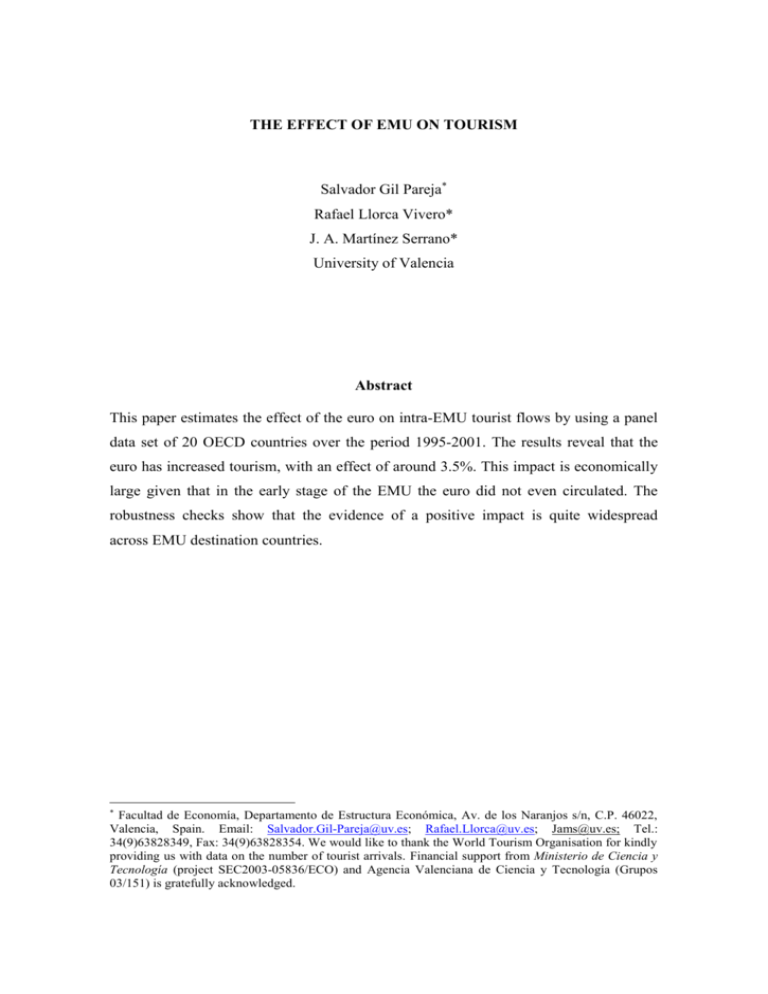
THE EFFECT OF EMU ON TOURISM Salvador Gil Pareja* Rafael Llorca Vivero* J. A. Martínez Serrano* University of Valencia Abstract This paper estimates the effect of the euro on intra-EMU tourist flows by using a panel data set of 20 OECD countries over the period 1995-2001. The results reveal that the euro has increased tourism, with an effect of around 3.5%. This impact is economically large given that in the early stage of the EMU the euro did not even circulated. The robustness checks show that the evidence of a positive impact is quite widespread across EMU destination countries. * Facultad de Economía, Departamento de Estructura Económica, Av. de los Naranjos s/n, C.P. 46022, Valencia, Spain. Email: Salvador.Gil-Pareja@uv.es; Rafael.Llorca@uv.es; Jams@uv.es; Tel.: 34(9)63828349, Fax: 34(9)63828354. We would like to thank the World Tourism Organisation for kindly providing us with data on the number of tourist arrivals. Financial support from Ministerio de Ciencia y Tecnología (project SEC2003-05836/ECO) and Agencia Valenciana de Ciencia y Tecnología (Grupos 03/151) is gratefully acknowledged. 1. Introduction The aim of this paper is to analyse the impact of the euro on tourism among the 12 members of the Economic and Monetary Union (EMU) in Europe. One of the expected effects of the creation of the single European currency was the increase in trade of goods and services, due not only to the elimination of exchange rate volatility and transaction costs, but also because a common currency enhances the transparency of markets (Emerson et al., 1992). Since the beginning of the EMU there has been widespread interest regarding to the magnitude of the foreseeable increase in trade. The first paper about the impact of currency unions on trade was Rose (2000), who found for a sample of 186 countries that, other things being equal, bilateral trade was three times higher for a pair of countries with the same currency than for countries with two different currencies. In the case of the EMU area, the effect of euro on trade has been analysed in several papers (Bun and Klaassen, 2002; Micco, Stein and Ordoñez, 2003; Gil, Llorca and Martínez Serrano, 2003; De Nardis and Vicarelli, 2003 and Barr, Breedon and Miles, 2003) and they have found a positive effect that ranges between 2.6% and 27% depending on the sample of countries, the periods analysed and the methodology used. But, all these studies are focused on merchandise trade. Historically it was thought that the only benefit from a monetary union would accrue to tourism (Subercaseaux, 1915, quoted by López-Cordova and Meissner, 2003). Nevertheless, to our knowledge, there is not any paper on the impact of a single currency on tourism. In fact, despite tourism being one of the most important domestic and international industries it has failed to attract the attention from mainstream economists.1 Tourism amounts to 10.2 % of world GDP and 11.2% of total exports of merchandise and services in 2002 (World Travel and Tourism Council, 2003). 1 Tourism, according to the World Tourism Organisation, "comprises the activities of persons travelling to and staying in places outside their usual environment for not more than one consecutive year for 1 Our paper attempts to fill a part of that gap by investigating the impact of EMU on tourist flows using data for 20 OECD countries over the period 1995-2001. This is the best sample we can consider for two reasons. First, since 1995 the WTO has promoted the harmonisation and comparability of tourism statistics, so data from previous years are not always homogeneous. Second, it is not sensible to consider flows with less developed countries since a large part of the flows that come from those countries are illegal immigration. Our empirical strategy draws on the most successful model for explaining trade flows, the gravity model. We find that, controlling for a host of other factors, the common currency has significantly increased tourist flows during 1999-2001. This result is quite widespread across EMU destination countries and, therefore, the overall results are not driven by the experience of just a few of them. Furthermore, the results reveal that effect of creating a currency union goes far beyond the elimination of exchange rate volatility. The contribution of this paper is twofold. First, it analyses for the first time the impact of the euro on international tourism. Second, it is the first time that the gravity model is applied to tourist flows.2 Moreover, in contrast to the studies on the impact of the euro on trade, we have been able to include price variables of origin and destination countries into the regressions, which is crucial according to theoretical gravity models. leisure, business and other purposes". In this paper we are interested in international tourism defined as "tourism of non resident visitor within the economy territory of the countries of reference". Hence, the tourism industry is an amalgam of industries such as transportation, accommodation, food and beverages services, leisure and entertainment, and travel agencies. 2 Nevertheless, it is important to note that Durbarry (2000) has applied the gravity model to international tourism expenditure in the UK and that Eilat^ and Einav (2003) estimate a multinomial logit model that resembles the gravity equation. 2 2.- The empirical model: The gravity equation Gravity models have been widely and successfully used in empirical work. Analogously to the Newtonian gravity equation, in economics, attraction between countries i and j depends directly on their economic sizes (masses) and inversely on the distance between them. These models have frequently been used to explain merchandise trade, investment, capital flows, or migration. Usually, the variable most representative of the economic size of countries is GDP. However, population is more suitable in the case of flows of people (migration, or tourists as in our case). The simplest empirical specification of the gravity equation takes the following form: X ij 0 (Yi ) 1 (Y j ) 2 ( Dij ) 3 uij (1) where Xij is the flow between countries, Yi and Yj are their economic sizes, Dij is distance between them and uij is a log-normally distributed error term. Gravity models used in international trade literature generally include, in addition to the aforementioned determinants, dummy variables that try to capture other factors influencing transaction costs either by reducing them (a common language, sharing membership in an integration agreement, or a common border) or by increasing them (insularity). Moreover, most authors also incorporate per-capita income of countries i and j into the list of independent variables. The economic intuition is that richer countries trade more because of better transportation infrastructures, a deeper compromise in the process of trade liberalisation (lower tariffs) or a higher number of varieties in production3. Some authors add a “remoteness” variable that try to capture the set of alternatives an importer country has. This is a weighed average of the distance across countries (including the internal distance of the country considered) in which the weigh is usually their economic size. However, as Anderson and van Wincoop (2003) demonstrate, this is not correct. When trade barriers are considered the adequate term to 3 3 Initially, gravity models lacked theoretical foundation but its success to empirically explain international trade has led economists to derive the gravity equation formally. The papers of Anderson (1979), Bergstrand (1985, 1989 and 1990) or Helpman and Krugman (1985) are necessary references on this issue. In all of them, the gravity equation is obtained from a general equilibrium model in which countries’ income represents the productive capacity of the exporter (supply side) and the absorptive capacity of the importer (demand side), and distance is a proxy of transport cost. Although it has been shown that the gravity equation is consistent with any international trade model (Deardorff, 1998 or Feenstra, Markusen and Rose, 2001) it seems that monopolistic competition and increasing returns to scale are assumptions that work empirically better for the case of industrial countries (Evenett and Keller, 1998). In addition, Bergstrand (1985) demonstrates that if there is not perfect substitutability of goods internationally in production and consumption (jointly with other restrictive assumptions) the gravity equation usually estimated omits some relevant price variables, implying a serious misspecification of the model. That is, if aggregate trade flows are differentiated by origin the inclusion of price terms in the model has to be considered.4 Now let us think about the phenomenon of tourism. The flow we analyse is the number of tourists arriving to destination i from country j. In this case, the variables that best measure the destination economic size are population and GDP per capita. Tourists demand not only natural and cultural resources but also the complementary services associated with leisure and business, such us infrastructures, restaurants and so on. include is a measure of the relative trade resistance, that is, the bilateral trade barrier compared with the average barrier of the two countries involved with all their partners. In this case, it is also essential the inclusion of price variables. Given that this model focus the attention on border barriers (probably very small or negligible in tourism) we prefer the direct approach of Berstrand (1985). An alternative procedure is to estimate the model with origin and destination country-specific dummies. For a discussion about the inclusion of prices on gravity models see Feenstra (2002). 4 Therefore, the richer and bigger a country is the greater will be its tourist services supply. With respect to the economic size of the origin country it seems evident that, ceteris paribus, the greater the population the larger the number of tourists. Additionally, because international tourism is a normal good in consumption (and, for most people a luxury one) per capita income of the origin country should also have a positive effect. It is quite clear the existence of nationally differentiated products in international tourism from both the supply and demand side. Each country offers a specific range of services (sun and beach, nature, culture, etc.) that differs from each other country and that is valued in a distinct way by consumers. Therefore, as Bergstrand (1985) points out the inclusion of the prices of the origin and destination countries is crucial in order to avoid a misspecification bias. Thus, following the work of Eilat^ and Einav (2003) we use a measure of the relative cost of living in the destination country with respect to the origin one through the use of the PPP conversion factor. As these authors note, it allows us to take into account the cross-sectional variation in the price of tourism as well as variations in real exchange rates over time. The dummy variables reflecting differences across countries in transaction costs have the same interpretation as in the case of merchandise trade except for trade agreements because this does not imply free trade (not applicable in this context) but probably more business tourism, expecting equally a positive effect of this factor. Finally, within this framework, we study the impact of the euro on tourist flows by introducing a dummy variable which takes a value of 1 when the two countries in the pair belong to the EMU at time t.5 4 In the Bergstrand model four complex price terms are derived. Empirically, exports and imports price index and GDP deflators (as well as an exchange rate index) are included in his regression. 5 In order to extract a pure effect of euro we also include a measure of volatility in our regression. 5 The estimating equation takes the following general form6: ln NTAijt 1 ln Popit 2 ln Pop jt 3 ln YPCit 4 ln YPC jt 5 ln Distij 6 ln RelativePPPijt 7 Languageij 8 Island ij 9Contiguityij (2) 10 FTAij 11 ln Volatilityijt 12 EMU ijt t ij uijt where: NTAijt is the number of tourists arrivals to country i from country j in year t, POPit is the population of country i in year t, POPjt is the population of country j in year t, YPCit is the real GDP per capita of country i in year t, YPCjt is the real GDP per capita of country j in year t, Dij is the distance between i and j, RelativePPPijt is the relative purchasing power parity between countries i and j in year t, Langij: is a dummy variable which is unity if i and j use a common language, Islandij: is a dummy variable with value 1 if there is an island in the pair, Contiguityij: is a dummy variable which is unity if i and j share a land border, FTA is a dummy variable that indicates common membership in a free trade agreement, Volatilityijt is the monthly exchange rate volatility between the currencies of countries i and j in year t, defined as 1 plus the variance of the first difference on the monthly natural logarithm of the bilateral nominal exchange rate, EMUijt is a dummy variable which is unity if i and j belong to the EMU in year t, t are year fixed effects, ij denotes individual effects for every destination-origin pair and uijt represents other influences on tourist flows assumed to be well behaved. 6 We add the corresponding variables in (1) and take natural logarithms. 6 The parameter of interest to us is 12. If EMU stimulates tourism among its members the coefficient 12 should be positive and statistically significant. 4. Results The effect of EMU on tourist flows is estimated by using gravity equations with panel data which allows us to control for unobservable individual effects. Table 1 shows the results for three variants of the equation (2). We report both fixed-effect and random-effect estimations. The random-effect model has the advantage of allowing the estimation of time-invariant variables. However, as it is well known, if individual effects are correlated with the explanatory variables the random-effect estimates are not consistent. The first and second columns report the estimates for the simplest formulation of that gravity equation. It includes as independent variables, in addition to the EMU dummy, the population and real GDP per capita of countries i and j, the distance and the relative PPP. Column 3 and 4 present the results when the dummy variables common language, island, contiguity and free trade area are added to the equation. Columns 5 and 6 show the estimates adding the exchange rate volatility variable to the regression. The Hausman tests reject the null hypothesis of no correlation of the individual effects with the explanatory variables (at the 1 per cent level) in the three variants of the gravity equation. Hence, the random-effect coefficients could be biased, and one should rely on the fixed-effect estimators. Nonetheless, before discussing the fixed-effect estimates, a couple of things are worth noting. First, the results for the parameter of interest (EMU) are very similar for fixed-effect and random-effect estimations. Second, the random-effect estimates of variables such us distance, common language and free trade agreement show the right sign, are highly significant, and economically large. 7 According to the fixed effect estimates, all the coefficients have always the expected sign. Moreover, with the exception of the real GDP per capita in the destination country and the exchange rate volatility, they are statistically significant at the 1 percent level. In particular, the coefficients of the population variable in both the origin and destination countries are positive and above unity. The real GDP per capita in the origin country presents values of the estimated coefficients close to unity. The coefficient for relative PPP is -0.3, which indicates that an increase in the relative price level of the destination country by 1% decreases the number of tourist arrivals by 0,3%. Focusing attention on the parameter of interest, the coefficient of the EMU variable is positive and statistically significant which suggests that EMU boosts tourist flows. The results show that the euro´s effect on tourism amounts to 3.6% when the exchange rate volatility is not included in the regression, and to 3.4% when it is added.7 While this effect is not spectacular, it is economically important, particularly if we consider that our sample only covers the first three years of the EMU, a period in which the euro did not even circulated.8 Moreover, the fact that the euro´s impact is estimated to be only slightly lower when the exchange rate volatility is included suggests that the elimination of the exchange rate variability is not the main channel through which the EMU affects tourist flows in our sample. This result is consistent with the evidence regarding the impact of exchange rate volatility on trade which has not yielded conclusive results.9 Thus, the EMU effect on tourism seems to be derived mainly from other factors such as the elimination of transaction costs arising from the need of exchanging different 7 Since trade is in logs, the impact of EMU is computed as exp(0.035)-1=0.036 and exp(0.033)-1=0.034. With the aim of checking the robustness of the estimations of the parameter of interest, we used GDPs instead populations and the results are essentially unaffected. 9 Although some studies show that the volatility of the exchange rates negatively affects bilateral trade flows this effect is generally small and not always statistically significant. For a literature review in this field, see European Commission (1998) and De Grauwe and Skudelny (2000). 8 8 currencies, the increase in market transparency, or the expansion of business tourism as a consequence of the positive impact of the EMU on trade. With the aim of checking whether the impact of the EMU is widespread among its member countries or, on the contrary, our results are driven by the experience of just a few of them, as a first robustness check, we have excluded one EMU destination country at a time from the sample. The results are presented in Table 2. To economise on space, we use the regression in columns 3 and 4 of Table 1, and we only report the estimated coefficients corresponding to the main parameter of interest. 10 The results are very robust to the exclusion of one destination country at a time. In particular, while the EMU coefficient for the whole sample is 0.035, with the exception of the BelgianLuxembourg case, the range of coefficients excluding one country at a time goes from 0.025 (excluding Italy) to 0.041 (excluding France), and they are always significant at the 5 per cent level. The only country that seems to be an outlier in the sample is Belgium-Luxembourg. Its exclusion from the data increases the magnitude of the EMU coefficient up to 0.058 (t-statistic equal to 4.49). In order to isolate the EMU effect in each of the individual EMU countries we have split the dummy EMU into two different dummies. Taking the case of Austria as an example, in the regression for this country, the first dummy “Austria EMU” takes the value of 1 for pairs formed by Austria (as the destination country) and other EMU countries, and zero otherwise. The second dummy “rest of EMU countries” takes the value of 1 for all other pairs of EMU countries. This procedure, in addition to provide another robustness check, allows us to tests whether the individual country EMU effect on tourism is significantly different from the rest of EMU. The results are presented in Table 3. As the table shows, there are five countries that are different from the rest. The 10 The inclusion of the log of volatility as an independent variable (regression in columns 5 and 6 of Table 1) does not affect the results in any significant way. 9 effect of EMU in Belgium-Luxembourg is highly significant, but with the wrong sing. This result is consistent with that found in Table 2 when Belgium-Luxembourg is excluded from the sample. It is not surprising given that the timing of tourist flows in our sample shows that the number of tourist arrivals to Belgium-Luxembourg from noneuroland nations has increased more than from other EMU member countries since the euro´s adoption in 1999. France also presents the wrong sing, but the effect is not statistically significant. At the opposite extreme, Greece, Italy and the Netherlands are the countries in which the EMU seems to have had the largest impact on tourism. In these three countries, the individual EMU coefficients are statistically different from those of other EMU countries. But, despite there are differences across destination countries regarding the effect of EMU on tourist flows, it is important to note that we find a positive and statistically significant impact in 8 out the 11 EMU destinations. Thus, the overall result is quite widespread across destination countries and does not seem to be explained by the experience of just a few of them. 5. Conclusions In recent years, several authors has investigated the consequences of sharing a common currency in Europe on merchandise trade arriving to the conclusion that the euro´s trade impact is positive. In this paper we use a panel data set over the period 1995-2001 for 20 OECD countries in order to study the impact of EMU on tourist flows. The estimation of the gravity equations shows that the euro has had also a positive and statistically significant effect on tourism even at this early stage of the common currency. In particular, the euro´s effect amounts to around 3.5% which is economically important if we consider that until 2002 the euro was only a unit of account. The robustness checks indicate that the evidence of a positive effect is quite 10 widespread across destination countries of the EMU and that the overall result does not seem to be explained by the experience of just a few of them. Moreover, we have found that the exchange rate volatility variable has a statistically insignificant effect on tourism. This is probably due to the fact that volatility between EMU member had already been low before EMU. Therefore, the effect of creating a currency union goes beyond the elimination of exchange rate volatility. References Anderson, J. E. (1979): "A theoretical foundation to the gravity equation", American Economic Review 69, pp. 106-116. Anderson, J. E. and van Wincoop, E. (2003): "Gravity with gravitas: A solution to the border puzzle", American Economic Review 93, pp. 170-192. Barr, D.; Breedon, F. and Miles, D. (2003): "Life on the outside: Economic conditions and prospects outside euroland", Economic Policy 18 (37), pp. 574-613. Bergstrand, J. H. (1985): "The gravity equation in international trade: some microeconomic foundations and empirical evidence", Review of Economics and Statistics 67, pp. 474-481. Bergstrand, J. H. (1989): "The generalised gravity equation, monopolistic competition, and the factor proportions theory in international trade", Review of Economics and Statistics 71, pp. 143-153. Bergstrand, J. H. (1990): "The Heckscher-Ohlin-Samuelson model, the Linder hypothesis, and the determinants of bilateral intra-industry trade", The Economic Journal 100, pp. 1216-1229. 11 Bun, M. J. G. and Klaassen, F. J. G. M. (2002): Has the euro increased trade?, Tinbergen Institute Discussion Paper, TI 2002-108/2. Deardoff, A. V. (1995): Determinants of bilateral trade: does gravity work in a neoclassic world?, NBER working paper 5377. De Grauwe, P. and Skudelny, F. (2000): "The impact of EMU on trade flows", Weltwirtschafliches Archiv 136, pp. 381-402. De Nardis, S. and Vicarelli, C. (2003): The impact of the euro on trade: the (early) effect is not so large, European Network of Economic Policy Research Institutes, Working Paper No. 017. Durbarry, R. (2000): Tourism expenditure in the United Kingdom: Analysis of competitiveness using a gravity-based model, Nottingham University Business School, mimeo. Eilat^, Y. and Einav, L. (2003): "The determinants of international tourism: a three dimensional panel data analisys", Applied Economics, forthcoming. Emerson, M.; Gros, D.; Italanier, A.; Pisani-Ferry, J. and Reichenbach, H. (1992): One market, one money: An evaluation of the potential benefits and costs of forming an economic and monetary union, Oxford University Press, Oxford. European Commission (1998): Currency management costs, The Single Market Review, Subseries III, Vol. 6, Brussels. Evenett, S. J. and Keller, W. (1998): On theories explaining the success of the gravity equation, NBER working paper 6529. Feenstra, R. C. (2002): "Border effects and the gravity equation: Consistent methods for estimation", Scottish Journal of Political Economy 49, pp. 491-506. 12 Feenstra, R. C.; Markusen, J. A. and Rose A. K. (2001): "Using the gravity equation to differentiate among alternative theories of trade", Canadian Journal of Economics 34, pp. 430-447. Gil, S.; Llorca, R. and Martínez Serrano (2003): “El euro y la integración comercial española: un análisis comparado”, Economía Industrial, No. 349. Helpman, E. and Krugman, P. (1985): Market structure and foreign trade. Increasing returns, imperfect competition, and the international economy, The MIT press. López-Córdova, E. and Meissner, C. (2003): "Exchange rates regimes and international trade: evidence from the classical gold era", American Economic Review 93, pp. 344353. Micco, A.; Stein, E. and Ordoñez, G. (2003): "The currency union effect on trade: Early evidence from EMU", Economic Policy 18 (37), pp. 315-356. Rose, A. K. (2000): “One money, one market: the effect of common currencies on trade”, Economic Policy 30, pp. 7-46. 13 Table 1. Panel estimations of the gravity equation. Dependent variable: log tourist flow. Sample period 1995-2001. (1) (2) (3) (4) (5) (6) R. E. F. E. R. E. F. E. R. E. F. E. EMUij 0.041 0.035 0.041 0.035 0.038 0.033 (3.43) (2.78) (3.42) (2.78) (3.08) (2.61) Ln Popi 0.754 1.059 0.767 1.059 0.769 1.175 (18.83) (2.53) (20.84) (2.53) (20.85) (2.77) Ln Popj 0.818 1.261 0.835 1.261 0.835 1.363 (20.46) (2.77) (22.72) (2.77) (22.71) (2.96) Ln Real GDP -0.220 0.172 -0.250 0.172 -0.256 0.149 per capitai (-2.66) (1.62) (-3.11) (1.62) (-3.18) (1.39) Ln Real GDP 0.922 0.931 0.953 0.931 0.953 0.919 per capitaj (11.48) (8.99) (12.22) (8.99) (12.22) (8.86) Ln Distanceij -0.997 -0.602 -0.602 (-22.99) (-5.95) (-5.94) Ln relative -0.313 -0.309 -0.315 -0.309 -0.315 -0.309 PPPij (-9.88) (-9.20) (-9.92) (-9.20) (-9.92) (-9.22) Common 1.447 1.444 Languageij (9.13) (9.09) Islandij -0.016 -0.013 (-0.19) (-0.15) Common 0.266 0.263 borderij (1.45) (1.43) FTAij 1.015 1.004 (4.47) (4.42) Ln Volatilityij -0.805 -0.791 (-1.63) (-1.58) Hausman test 63.60 64.90 64.40 (marginal pr.) (0.00) (0.00) (0.00) No. Observ. 2220 2220 2220 2220 2220 2220 No. Groups 352 352 352 352 352 352 Year Dummies Yes Yes Yes Yes Yes Yes Note: t-statistics in parentheses are robust to heteroscedasticity and autocorrelation. 14 Table 2. Panel estimation of the EMU coefficient with single euroland countries excluded from the sample. Dependent variable: log tourist flow. Sample period 19952001. Country dropped EMU coefficient Hausman test (t-statistic) None (original sample) 0.035 65.15 (2.78) [0.00] Austria 0.035 74.89 (2.67) [0.00] Belgium-Luxembourg 0.058 61.15 (4.49) [0.00] Finland 0.037 55.21 (2.81) [0.00] France 0.041 62.18 (3.08) [0.00] Germany 0.032 68.46 (2.33) [0.00] Greece 0.027 60.62 (2.07) [0.00] Ireland 0.029 41.15 (2.25) [0.00] Italy 0.025 63.64 (2.02) [0.00] Netherlands 0.033 61.76 (2.48) [0.00] Portugal 0.039 64.33 (2.91) [0.00] Spain 0.033 52.56 (2.52) [0.00] Note: The regressions include population, real GDP per capita, distance, relative PPP, plus dummies for EMU, common language, insularity, common border, free trade agreement and years as independent variables. t-statistics in parentheses are robust to heteroscedasticity and autocorrelation. According to the Hausman test the reported estimated coefficients are those of the fixed effects model. The marginal significance levels for the Hausman tests appear in square brackets. 15 Table 3. The effect of the EMU, member by member. Dependent variable: log tourist flow. Sample period 1995-2001. Country Coefficient Hausman test Wald test (t-statistic) [marg. prob.] [marg. prob.] Austria Austria EMU 0.063 66.46 0.94 (2.01) [0.00] [0.33] Rest of EMU countries 0.032 (2.42) BelgiumBelgium-0.221 59.71 86.08 Luxembourg Luxembourg EMU (-7.31) [0.00] [0.00] Rest of EMU countries 0.067 (5.20) Finland Finland EMU 0.071 65.15 1.11 (1.95) [0.00] [0.29] Rest of EMU countries 0.032 (2.49) France France EMU -0.038 63.93 5.21 (-1.10) [0.00] [0.02] Rest of EMU countries 0.043 (3.28) Germany Germany EMU 0.074 68.64 1.82 (2.36) [0.00] [0.18] Rest of EMU countries 0.030 (2.29) Greece Greece EMU 0.149 64.72 7.77 (3.49) [0.00] [0.01] Rest of EMU countries 0.025 (1.92) Ireland Ireland EMU 0.072 51.27 0.90 (1.77) [0.00] [0.34] Rest of EMU countries 0.033 (2.55) Italy Italy EMU 0.121 67.51 6.45 (3.35) [0.00] [0.01] Rest of EMU countries 0.027 (2.07) Netherlands Netherlands EMU 0.095 66.34 4.04 (2.94) [0.00] [0.04] Rest of EMU countries 0.028 (2.09) Portugal Portugal EMU 0.040 64.92 0.03 (1.24) [0.00] [0.86] Rest of EMU countries 0.035 (2.66) Spain Spain EMU 0.081 65.91 1.47 (2.04) [0.00] [0.23] Rest of EMU countries 0.032 (2.45) Note: The regressions include population, real GDP per capita, distance, relative PPP, plus dummies for EMU, common language, insularity, common border, free trade agreement and years as independent variables. t-statistics in parentheses are robust to heteroscedasticity and autocorrelation. According to the Hausman test the reported estimated coefficients are those of the fixed effects model. For each EMU country, the Wald statistic tests the null hypothesis of equality of the EMU coefficient in the corresponding country and in the remaining EMU countries. The marginal significance levels appear in square brackets. 16 Data appendix Our dependent variable is the annual number of tourists arrivals to each destination from each origin country. These series are taken from World Tourism Organization. The sample includes 20 OECD countries (Belgium and Luxembourg considered jointly) during the period 1995-2001. The choice of 1995 as the initial date of the sample period is determined by fact that from this year the WTO has promoted the harmonisation and comparability of tourism statistics internationally and the new series are not always compatible with the historical data. In particular, the countries considered in this study are: Australia, Austria, Belgium-Luxembourg, Canada, Denmark, Finland, France, Germany, Greece, Ireland, Italy, Japan, Netherlands, New Zealand, Norway, Portugal, Spain, Switzerland, United Kingdom, and United States. Despite the fact that our sample focuses on developed countries over the recent years, some values are missing and, therefore, we have estimated unbalanced panels. The independent variables are obtained from different sources. The GDPs in real terms and national currency are taken from the database National Accounts I (OECD). For non-euroland countries, these series are converted to euros using 1999 exchange rates. The population variable and data on PPP for GDP come also from the National Accounts I database. The distance data (great-circle distances) are taken from Andrew Rose website (www.haas.berkeleyedu/arose). Finally, monthly exchange rates used to construct the variable that measures the exchange rate volatility are obtained from International Financial Statistics (IMF). 17
